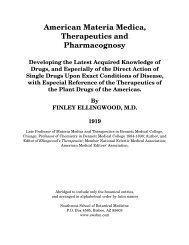SCARLET FEVER. Synonyms.—Scarlatina; Scarlet Rash. Definition ...
SCARLET FEVER. Synonyms.—Scarlatina; Scarlet Rash. Definition ...
SCARLET FEVER. Synonyms.—Scarlatina; Scarlet Rash. Definition ...
You also want an ePaper? Increase the reach of your titles
YUMPU automatically turns print PDFs into web optimized ePapers that Google loves.
From two weeks to three months is the usual period, though it may be<br />
prolonged to one year or more. The wound frequently heals as readily<br />
from the bite of a rabid dog as from one not affected.<br />
Prodromal symptoms are headache, loss of appetite, and a depression<br />
that is somewhat characteristic, the patient being melancholy, with the<br />
sense of impending danger. There may be a stinging sensation or<br />
itching at the seat of the bite, and the part becomes numb; sometimes<br />
the cicatrix becomes red and swollen. These symptoms last from one to<br />
three days.<br />
The patient is restless and uneasy, and the slightest noise, a flash of<br />
light, a draft of air, or a sudden call, will produce undue excitement; or<br />
the patient sits quietly in a despondent mood, with an occasional sigh.<br />
As the disease progresses towards the spasmodic or true hydrophobic<br />
stage, respiration becomes oppressive and the voice rough, and a seizure<br />
may be expected momentarily; this stage lasts from one to three days.<br />
The second stage is characterized by spasmodic contraction of the larynx<br />
on attempts at swallowing. The sight of water produces great fear, and<br />
often precipitates a spasm which is attended with great suffering; the<br />
dyspnea is great, and the convulsive action of the larynx and muscles of<br />
the mouth causes the patient to emit guttural sounds, which, to the<br />
excited and horror-stricken observer, seem to resemble the bark or howl<br />
of a dog. The temperature is usually slightly elevated, from 100° to<br />
103°, though the temperature may be subnormal.<br />
These paroxysms occur at intervals; when the seizure subsides, the<br />
mind is perfectly clear, though the patient is greatly exhausted. In<br />
extreme cases, the patient is maniacal, and must be prevented from<br />
injuring himself or attendant. This stage lasts from one to three days,<br />
and gradually passes into the third stage, known as the paralytic stage.<br />
The paroxysms become less violent, the patient being able to swallow<br />
with some difficulty, the prostration is great, the heart's action feeble,<br />
the skin is relaxed, and the surface is covered with a cold sweat. The<br />
mind, which has been clear during the interval of intense suffering,<br />
now becomes clouded, and the patient finally passes into coma, the<br />
spasms entirely subside, and in from ten to twenty hours the patient<br />
expires.<br />
The Eclectic Practice of Medicine - PART I - Infectious Diseases - Page 247

















